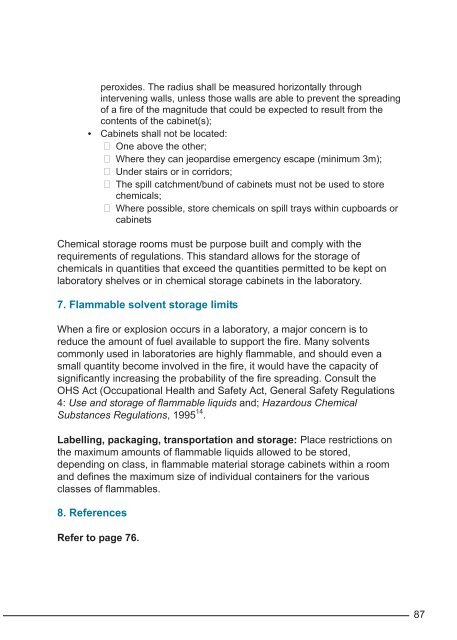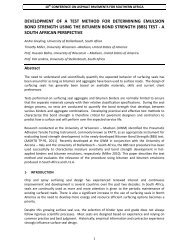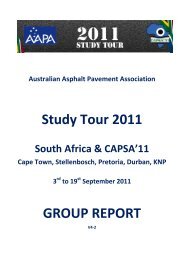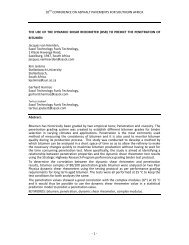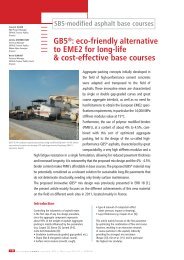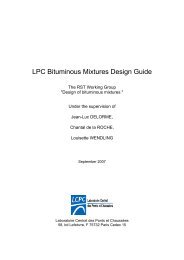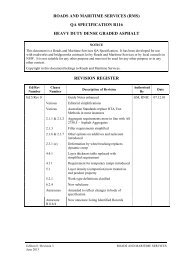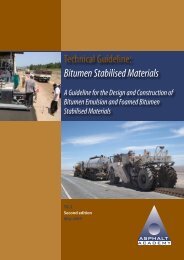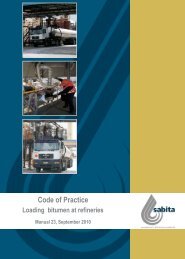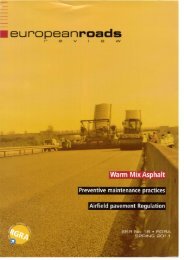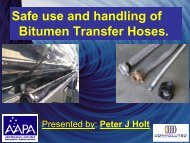Guide to the safe handling of solvents in a bituminous ... - Aapaq.org
Guide to the safe handling of solvents in a bituminous ... - Aapaq.org
Guide to the safe handling of solvents in a bituminous ... - Aapaq.org
- No tags were found...
You also want an ePaper? Increase the reach of your titles
YUMPU automatically turns print PDFs into web optimized ePapers that Google loves.
peroxides. The radius shall be measured horizontally through<strong>in</strong>terven<strong>in</strong>g walls, unless those walls are able <strong>to</strong> prevent <strong>the</strong> spread<strong>in</strong>g<strong>of</strong> a fire <strong>of</strong> <strong>the</strong> magnitude that could be expected <strong>to</strong> result from <strong>the</strong>contents <strong>of</strong> <strong>the</strong> cab<strong>in</strong>et(s);• Cab<strong>in</strong>ets shall not be located: One above <strong>the</strong> o<strong>the</strong>r; Where <strong>the</strong>y can jeopardise emergency escape (m<strong>in</strong>imum 3m); Under stairs or <strong>in</strong> corridors; The spill catchment/bund <strong>of</strong> cab<strong>in</strong>ets must not be used <strong>to</strong> s<strong>to</strong>rechemicals; Where possible, s<strong>to</strong>re chemicals on spill trays with<strong>in</strong> cupboards orcab<strong>in</strong>etsChemical s<strong>to</strong>rage rooms must be purpose built and comply with <strong>the</strong>requirements <strong>of</strong> regulations. This standard allows for <strong>the</strong> s<strong>to</strong>rage <strong>of</strong>chemicals <strong>in</strong> quantities that exceed <strong>the</strong> quantities permitted <strong>to</strong> be kept onlabora<strong>to</strong>ry shelves or <strong>in</strong> chemical s<strong>to</strong>rage cab<strong>in</strong>ets <strong>in</strong> <strong>the</strong> labora<strong>to</strong>ry.7. Flammable solvent s<strong>to</strong>rage limitsWhen a fire or explosion occurs <strong>in</strong> a labora<strong>to</strong>ry, a major concern is <strong>to</strong>reduce <strong>the</strong> amount <strong>of</strong> fuel available <strong>to</strong> support <strong>the</strong> fire. Many <strong>solvents</strong>commonly used <strong>in</strong> labora<strong>to</strong>ries are highly flammable, and should even asmall quantity become <strong>in</strong>volved <strong>in</strong> <strong>the</strong> fire, it would have <strong>the</strong> capacity <strong>of</strong>significantly <strong>in</strong>creas<strong>in</strong>g <strong>the</strong> probability <strong>of</strong> <strong>the</strong> fire spread<strong>in</strong>g. Consult <strong>the</strong>OHS Act (Occupational Health and Safety Act, General Safety Regulations4: Use and s<strong>to</strong>rage <strong>of</strong> flammable liquids and; Hazardous ChemicalSubstances Regulations, 1995 14 .Labell<strong>in</strong>g, packag<strong>in</strong>g, transportation and s<strong>to</strong>rage: Place restrictions on<strong>the</strong> maximum amounts <strong>of</strong> flammable liquids allowed <strong>to</strong> be s<strong>to</strong>red,depend<strong>in</strong>g on class, <strong>in</strong> flammable material s<strong>to</strong>rage cab<strong>in</strong>ets with<strong>in</strong> a roomand def<strong>in</strong>es <strong>the</strong> maximum size <strong>of</strong> <strong>in</strong>dividual conta<strong>in</strong>ers for <strong>the</strong> variousclasses <strong>of</strong> flammables.8. ReferencesRefer <strong>to</strong> page 76.87


